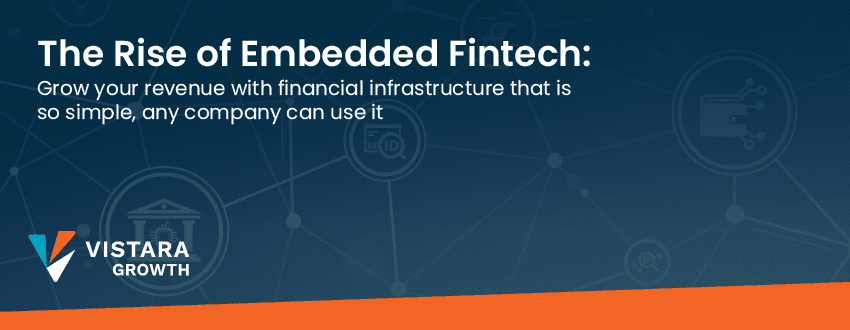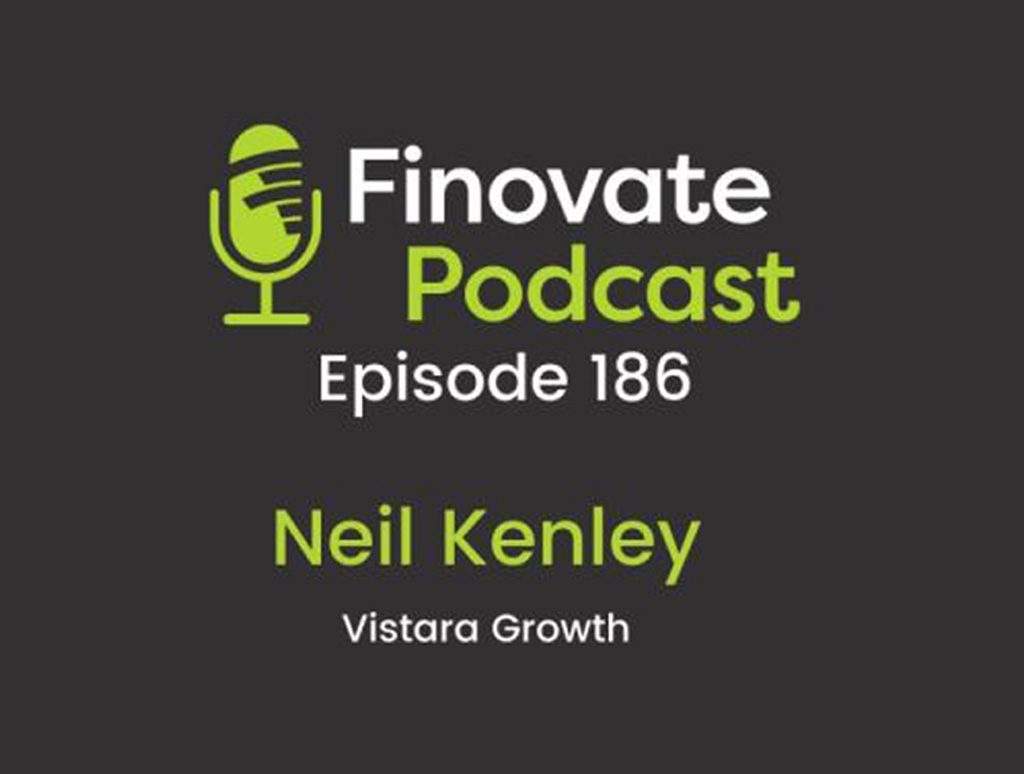
Neil Kenley, Vistara’s fintech expert, shares an overview of how advances in financial infrastructure are creating opportunities for every company to embed financial products into their offering.
Financial technology (fintech) is rapidly becoming a greater part of our every day lives. Now there are dozens of Neo banks vying for our attention and more free financing options than ever when buying that new couch. We have seen an explosion of financial services products offered to both consumers and businesses over the past few years, and that is in no small part due to an increase in venture-backed companies building out the ecosystem. With $34bn of investment made into the fintech sector in Q2 2021 alone, the opportunity has clearly been recognized by the venture capital community. CB Insights reports that this figure represents as much as 20% of all venture dollars invested in the quarter (Source).
One particular idea, which has been gaining significant traction, is embedded fintech; a segment that is expected to grow to ~$230 billion in revenue by 2025 (in the US alone), more than 10x where it is today. (Source)
What is Embedded Fintech and Why is it Thriving Now?
More and more non-financial businesses are providing financial products to their customer base and streamlining the customer experience in the process. By utilizing their distribution network and data, technology companies can offer unique financial services to their customers, adding meaningful new revenue streams while also creating longer lasting relationships with customers and lowering churn.
This can be as simple as using your own embedded payment stack that allows you to retain processing fees that are normally captured by incumbents like Stripe and Paypal, or more sophisticated offerings that easily allow vertical software companies to provide bank accounts, loans or working capital to their customers.
These types of offerings have been become more prevalent because it has never been easier to create financial products. On the back of open banking regulations, the infrastructure layer of financial services is now being built out, allowing companies to build banks, process payments, issue credit cards, loans or insurance all through the use of APIs. The historical need for tech companies to directly partner with financial institutions is no longer required, creating endless opportunities for new solutions.
Embedded Fintech in Action: An Easy Way to Add Top-Line Growth
When it comes to embedded fintech, there is no one-size solution for non-financial companies. Businesses have been able to grow their top line while providing value-added products to their userbase in a number of ways.
Embedded Insurance
Recently, Hodinkee a media company and marketplace for luxury watches launched a seamless insurance product into their offering. Hodinkee users can instantly sign up for a low-cost insurance product that protects their watch, without ever leaving the Hodinkee website. Hodinkee acts as the insurance broker while Chubb underwrites the policies. By acting as the insurance broker they are able to collect a meaningful amount of insurance premiums, on top of the revenue from their core business.
Embedded Lending
We have seen the rise of ‘buy now pay later’, in the consumer segment with companies like Affirm, Klarna, Apple and Afterpay providing credit to consumers. We see similar dynamics popping up within the professional services and B2B segments. LegalMate is BNPL (Buy Now, Pay Later) for the legal industry and provides lawyers with the option to extend credit to their clients and receive their invoices upfront to better manage cashflow and eliminate any collections risk. LegalMate allows clients to pay overtime and manages all collections and monitoring, allowing lawyers to focus on their practice.
Embedded Banking
By using banking as a service platforms like Unit and Moov, companies are able to build banking products in weeks not years, without the need for bank licenses. This allows companies to create bank accounts for customers, issue debit cards with unique features and manage invoices and payments. Recently, Unit worked with Wethos (an end-to-end platform for freelancers) to provide their users with free business bank accounts and debit cards. Not only does this create increased loyalty and stickiness, but it also allows the company to earn net interest income on deposits and ACH/Interchange fees from their debit transactions.
Embedded Payments
Companies like Tilled are building the infrastructure that allows software providers to rapidly act as a payments facilitator (“PayFac”) without large upfront costs or increased risk (Tilled manages the KYC, fraud management and the chargeback process). By leveraging Tilled, companies can quickly monetize any payments flowing through their software using an easy-to-implement API. For example, if your customers are processing >$100M in payments through your software, there could be an opportunity to capture more than an additional $400K per year by acting as a PayFac.
Challenges to Incumbent Financial Institutions
The rapid pace of financial innovation and new data-driven financial products are having an impact on incumbent financial institutions. Customers are asking for more personalized products and pricing that better represents their unique profile. Given the more siloed nature of data within many traditional financial institutions, they struggle to combine this information into a unified view of their customer and are unable to provide a level of service on par with todays fintech offerings or digital first banks. Our portfolio company Zafin knows a thing or two about solving these issues for financial institutions. Zafin’s SaaS product and pricing platform is a key part of any core modernization journey, creating the backbone needed to allow financial institutions to deliver digitally enabled personalization for products and pricing. Their easy-to-use interface allows banks to rapidly deploy bespoke products, personalized pricing and offers, as well as packages and experiences that are highly tailored based on a 360o view of the customer.
Vistara is Poised to Support the Opportunity for Innovation in Fintech
We at Vistara Growth believe there are numerous unique business models and opportunities arising everyday in the embedded fintech space that may make it difficult for traditional lenders to react. We are incredibly excited by the sector and are looking for ways to support the ecosystem.
If you are a vertical software provider thinking about embedding finance into your offering, or if you are building the infrastructure that powers this segment, we would love to connect with you and explore how we can help enable your growth.

About Vistara
Vistara Growth provides highly flexible growth debt and equity solutions to leading technology companies across North America. Founded, managed, and funded by seasoned technology finance and operating executives, “Vistara” (Sanskrit for “expansion”) is focused on enabling growth for the ambitious entrepreneurs we invest in, our investors, our people, and the communities we operate in.
Interested in Growth Funding?
If you’re interested in growth funding for your mid-stage technology company, talk to us! We would be delighted to discuss our flexible growth capital solutions.











